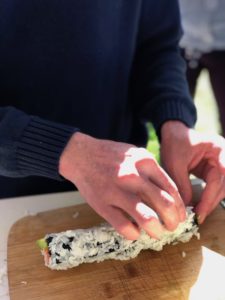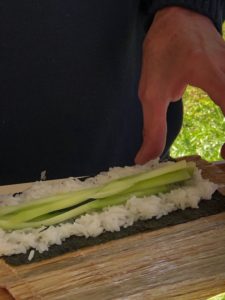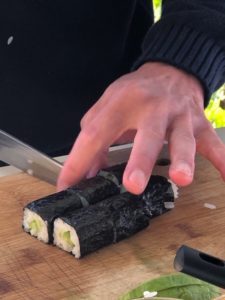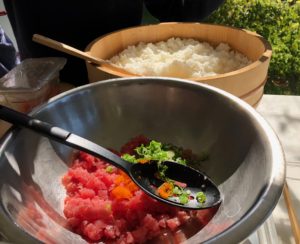(Gerry Furth-Sides) Santorini, often described as the ultimate of the hundreds of Greek islands with whitewashed buildings tumbling down the dramatic hills to a pristine, turquoise ocean. I speak from experience. Fact: sunsets have earned a reputation for being so spectacular that the price of a house is influenced by the view of these sunsets from its roof.
Who would suspect with this view that this most popular of islands for its beaches and clubs has been making wine for over 3000 years? It turns out that the very dramatic rocky landscape, which plunges sharply down to the sea, is also the foundation of these unique Santorini wines. That’s because a mammoth volcanic eruption between 1645 and 1500 B.C. resulted in superb volcanic soils in which the grapes are grown. Santorini also happens to be one of the few self-rooted vineyards in the world with close to forty native varieties of grapes. With Greek ingenuity and know how, the vines lay low to the ground in round baskets made from the vines themselves protects them from the high winds.
We already tried and wrote about wines from Santorini but this is the first time learning about the vineyards. See the story at: //localfoodeater.com/new-georgos-wine-half-california-half-greek-like/

Wine glasses at Republique Restaurant ready for the Santorini wine tasting that was part of a world tour
 The result is bright wines with a pleasant acidity and a distinctive touch of minerality from the volcanic soils in which the grapes are grown. Most of the wines are white, made from Santorini’s premier wine grape Assyrtiko along with two other local grapes, Athiri and Aidani.
The result is bright wines with a pleasant acidity and a distinctive touch of minerality from the volcanic soils in which the grapes are grown. Most of the wines are white, made from Santorini’s premier wine grape Assyrtiko along with two other local grapes, Athiri and Aidani.
The light yellow color of the white Santorini wine is so rich it almost looks like olive oil. Santo sparkling brut 2015 is made in the traditional Champagne method and 100% Assyrtiko. It is the first assyrtiko sparkler produced by a Santorini winery in Santorini. The bone-dry yet fruity Santorini Assyrtiko 2018 paired with a round of tuna tartare would work well with any fish or seafood, and even stand up to a spicy Asian cuisine. Favorite in the group was the golden Assyrtiko Grande Reserve 2017, saturated with flavor, aged in oak, was outstanding among the Santorini wines. Another favorite of mine was the Vinsanto 2012 made of sun-dried grapes and aged in oak for three years with an 85% Assyriko and 15% Aidani composition. It was perfect on its own as a dessert wine because it is as rich as a liquor, it also has a hint of Greece’s prize honey and raisons and would complement most desserts.

The golden Assyrtiko Grande Reserve 2017, saturated with flavor, aged in oak, was the favorite among the Santorini wines.
République chefs featured Greek tomato paste and fava beans in original appetizers and ones from their catering menu. Big eye tuna tartare with Santorini tomatoes and kaluga caviar; Gioia burrata toast with Santorini favas and Périgord black truffle.
The Diamond Wine Importers website provides information on Santorini wines including a glossary of Greek wine varieties, and a photo gallery showing how Santorini’s dry-farmed grape vines are trained to grow so close to the soil on Santorini’s location in the South Aegean, is shown on the map below. And while many wonderful wines from overseas are introduced to us here in America, there is nowhere to purchase them. But the Greeks have covered this with a list of Greek wine distributors throughout the United States.
Greek know-how even enables farmers to utilize the outstanding climate on the steep hills, where fava beans and tomatoes rival the famous Greek olives. To increase public awareness, a three-year international campaign called “Unbox Santorini Volcanic Terroir” is underway with a focus on PDO agricultural products or Protected Designation of Origin. Funded by the European Union and Union of Santorini Cooperatives “Santowines,” this campaign focuses on wine, fava beans and Santorini tomatoes.
The tourist draw adds to the allure of the wines with Santorini home to hundreds of restaurants, bars and cafes in which to drink wine. Industrious, gnarled old men even sell their home-made wine in plastic water bottles on the street. Epharisto!




























































































 Gerry Furth-Sides
Gerry Furth-Sides  Barbara Hansen
Barbara Hansen  Chef-owner Alain Cohen
Chef-owner Alain Cohen  Roberta Deen
Roberta Deen  Jose Martinez
Jose Martinez  Nivedita Basu
Nivedita Basu